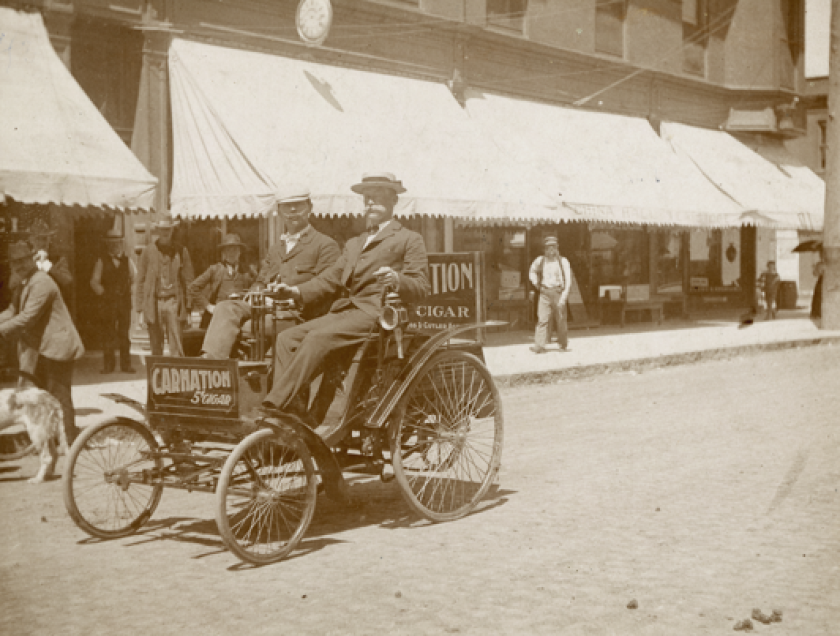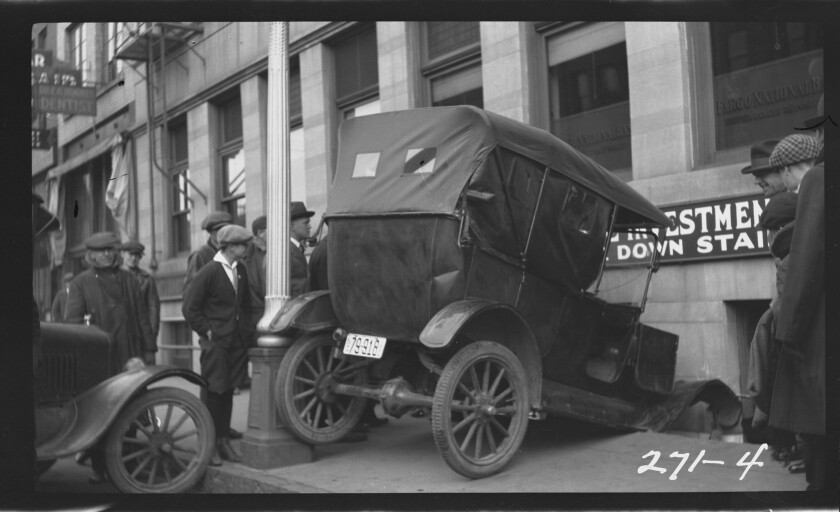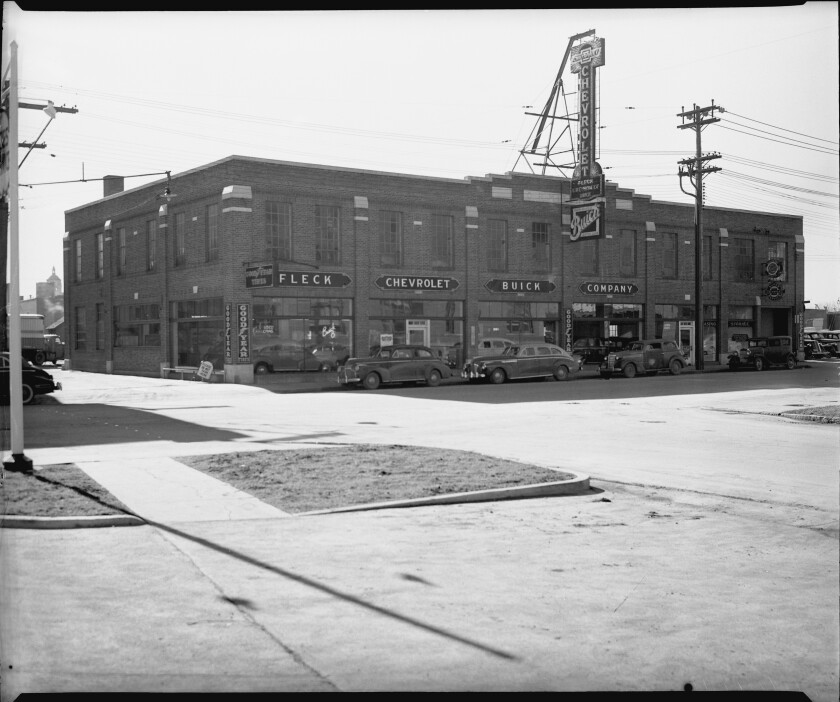FARGO — In the 1890s, gas-powered motorcars started showing up on America’s streets.
It didn’t take long for the “horseless carriage” to get into North Dakota, shifting transportation here into a new gear.
That drive to modernize is marked by buildings still standing in downtown Fargo, once the industrial heart of the city, including the Ford Building, Pence Building and a spot on N.P. Avenue that started as Mitchell Chevrolet.
To get us rolling ….
It was late June 1897 that a German-built Benz Velo tooled first through Grand Forks, and then was part of a downtown Fargo parade on July 3.

A North Dakota State University Archives photo shows the open, two-seat Benz Velo being driven down the Syndicate Block of Broadway, decorated with ads hawking the Carnation 5-cent cigar.
The NDSU Archives says the first two gasoline-engine automobiles in Fargo were both one-cylinder Oldsmobiles purchased by wealthy landowner G.S. Barnes and Fargo banker R.S. Lewis.
(Though, reportedly at least two electric motorcars preceded them.)
Lewis and Barnes showed off their cars in Fargo's first automobile race on July 4, 1900.
ADVERTISEMENT
The two-man race was expanded at the last minute when a Minneapolis man joined the race with his two-cylinder Cadillac. The three racers began on Front Street (Main Avenue) raced west to 13th Street, south to Third Avenue, and east to Eighth Street on which the race ended. Lewis passed Barnes on Eighth Street to win.
The first company to sell autos in Fargo was Frank Lynch and Co, established in 1904. They sold the Ford, Brush, and Velie makes of cars.

Another early car dealership was More Brothers on Front Street, established in March 1909, and selling Lambert, Richmond and Wescott cars.
The Forum reported on June 24, 1909, that there were more than 125 automobiles in daily use in Fargo. The Forum said that on "Almost any day one can count several of these buzz wagons while walking a block."
Soon, thanks to Henry Ford, Fargo would get what is now a distinctive piece of downtown history.
Ford focuses on Fargo
The Ford Motor Company opened its first factory branch in downtown Fargo in March 1910 in the Frank Lynch Building at 17 Broadway between Front Street (now Main Avenue) and NP Avenue.
That location assembled, sold and serviced Model Ts for retail and wholesale customers in North and South Dakota. In September 1911, the operation moved to 209-211 NP Avenue.
ADVERTISEMENT
The Jan. 1912 issue of The Ford Times reported that Manager C.F. Reynolds “and his corps of assistants have been selling Model Ts from the new headquarters of our Fargo branch,” which was described as being “in the automobile district of Fargo.”
“It is in easy reach of all prospects who desire to look over the different makes of motor cars in Fargo,” the Ford Times said.

Bigger things were on the drawing board.
Construction on the Ford Building at 505 Broadway was started in the latter part of 1914 and was finished in late August 1915 with a price tag of more than $150,000. It included a Great Northern Railway spur built into the building.
July 23, 1915, was designated “Ford Day” by the city of Fargo to celebrate the concrete and steel building. The 55-piece “big Ford band” played a concert in Island Park, and there was an automobile show at the fairgrounds and sales by merchants.
The 57,800-square-foot branch building was Ford’s 25th. At the time, Ford was building such assembly plants around the country to decentralize the manufacture of cars and trucks. It opened with 75 employees, and staff grew to about 200.
Ford archivist Marguerite Moran told a Forum reporter that while the building was designed to accommodate assembly on the third floor, it was never actually used for building cars.
ADVERTISEMENT
Ford had opened three dozen branches between 1904 and 1919 throughout the country, most of them in large cities, such as Detroit, New York, Philadelphia, Boston, Chicago, Houston and San Francisco. But a few were in smaller cities, such as Fargo. In fact, the Fargo branch opened nearly two years earlier than the Minneapolis branch, according to information supplied by Ford to Mutschler Bartram Architects.
Retail and wholesale sales of autos and parts were in the Ford Building, as well as a service repair department, which also taught dealers how to run service and repair shops.
“Ford branch houses were situated at strategic points where freight rates changed, affecting shipping costs. As the branches grew numerous, they gave a much better control of the company business throughout the country than the use of wholesale distributors,” according to “Ford. The Times, The Man, The Company,” by Allan Nevins.

In March 1933, the office began operating as a sales office, with parts and accessories transferred to other offices.
In Feb. 1935, it reopened as a sales and service branch through at least Feb. 27, 1941. By 1948, the building was renamed the Fargo Parts Depot and no longer included vehicle sales.
The depot closed in February 1956 and was sold to F.C. Hayer Co., a household appliance firm. By 1961, Kaye’s Printing was also operating in the building.
In 1999, Forum Communications bought the building and Kaye’s Printing. And in 2004, the building was sold to MBA and Sterling Development and redeveloped into retail and office space and condominiums.
ADVERTISEMENT
Pence Automobile
The Pence Automobile Co. warehouse building still stands at 301 N.P. Ave.
“Ghost signs” with the company’s name painted on the brick adorn the north and west sides of the building, a reminder of its origins.
Today, Fargoans know it as the home of Family HealthCare.
The three-story structure, built in the Classical Revival style, was completed in 1920 at a cost of more than $175,000.

It was designed to be the premier automobile sales and service center in the area.
Andrea Halgrimson, a former Forum librarian, columnist and devotee of local history, wrote about the Pence Building in 2010. Harry E. Pence, for whom the business was named, was born in 1867 Ohio. He moved to Minneapolis at age 18.
Pence founded Pence Automobile Co. in 1903. He sold Cadillacs at first, but later switched to Buicks. Pence at one time sold 29% of all Buicks being built.
ADVERTISEMENT
A few years later, the Pence Automobile Co. built an eight-story building in downtown Minneapolis.
Expansion brought the company to Fargo.
The Fargo building had been home to many businesses over the years, Halgrimson wrote.

In 1934, Vincent-Kelly Inc., distributors of Dodge and Plymouth cars and trucks, occupied the Pence building.
By 1940, Dakota Tractor and Equipment Co. - distributors of Caterpillar Tractors, road machinery and contractors' equipment, occupied the building.
In July 1941, it was purchased by J.A. Fleck to be used as a reconditioning plant for used cars. Fleck’s new car business, Fleck Chevrolet Buick, continued in a building at 82 NP Ave.
Reinhard Brothers, wholesale automotive supply dealers, bought the Pence building from the estate of J.A. Fleck.
Reinhard at the time was also a distributor for Norge home appliances and Zenith radios and hearing aids, later growing its product lines to include Gibson, Frost Queen and Waste King appliances, lawn equipment and Armstrong carpet.
Between 1990 and 2007, it was occupied by Richtman’s Printing and Packaging.
In 1994, the Pence building was put on the National Register of Historic Places.
It was purchased in 2007 by Fargo’s Kilbourne Group, along with three adjoining buildings. Kilbourne Group rehabbed the buildings, and the Pence building and 307 and 309 NP were sold in 2011 to what was then Fargo Family HealthCare Center.
Several lives
In 1927, Orin R. Mitchell, a South Dakota native, became a Chevrolet dealer in Fargo.
About 1928, construction was started on the Mitchell Chevrolet building at 820 N.P. Avenue, and it was completed in 1930, according to a photo in the NDSU Archives.

In August of 1937, Bismarck auto dealer Jack A. Fleck bought an ownership stake in Mitchell Chevrolet and became the operating partner, the Bismarck Tribune reported.
Fleck “has been one of North Dakota’s outstanding automobile dealers since he first opened a sales agency in Bismarck in 1924,” the Tribune reported.

By the early 1940s, an NDSU Archives photo shows the Chevy dealership renamed as Fleck Chevrolet Buick Company.
(Fleck, of course, also used the Pence building as a place to recondition cars.)

Meanwhile, W.W. Wallwork, who had been selling cars since 1921, starting on Center Avenue in downtown Moorhead, bought a Ford dealership in 1937 at 414 4th Ave. N., in Fargo
In August 1945, The Fargo Forum and Daily Tribune reported that W.W. Wallwork had purchased the Fleck building and it became a W.W. Wallwork Ford dealership.
In 1968, Wallwork’s son, W.W. Wallwork Jr., closed the Moorhead and downtown Fargo locations and opened a dealership on Main Avenue in Fargo
Sometime later, the building became part of Fabricators Unlimited and is currently addressed as 828 N.P. Ave.














